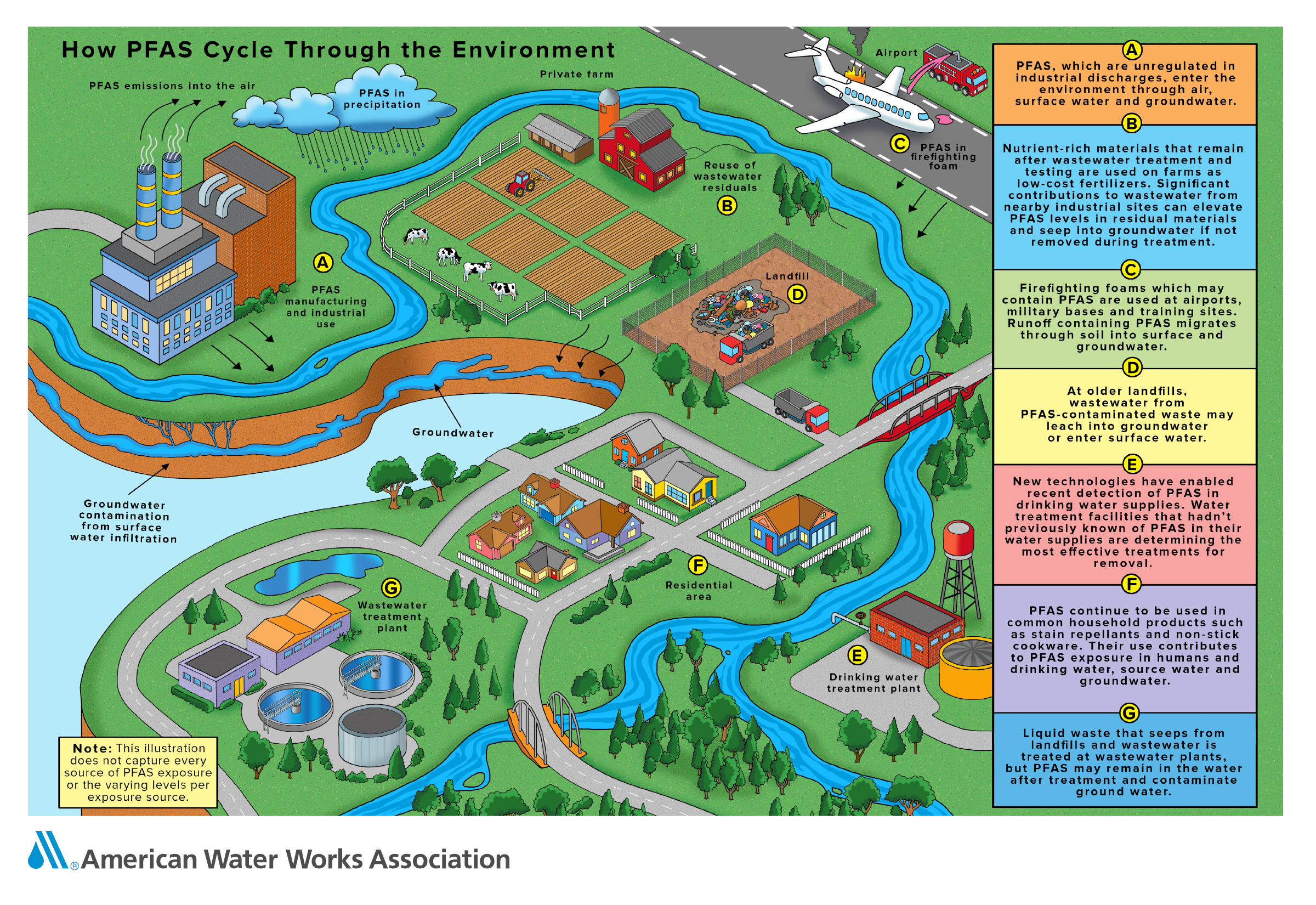


What it is, where it comes from, and what are the impacts on drinking water.
PFAS (Per- and Polyfluoroalkyl substances)
PFAS are a large group of man-made chemicals that have been manufactured and used around the world since the 1940s for many industrial and consumer purposes including the coating of fabrics, nonstick cookware, food packaging, and firefighting foam.
These chemicals can accumulate over time and have been found in both the environment and the human body. They do not break down easily in the environment or the human body and are sometimes called “forever chemicals”.
Of these chemicals, the most extensively produced and studied have been PFOA and PFOS.
How do these chemicals get into the environment?
How these chemicals get into groundwater is still being studied, but PFAS in drinking water usually comes from a nearby source such as a facility where it is produced, used or disposed.
Assessments of potential risks of PFAS in areas tributary to our drinking water supplies was conducted in 2019 in accordance with DPH guidance. Sites that were identified as potential PFAS generators have been prioritized for sanitary inspections by the company.
PFAS can also enter water sources from Aqueous Film Forming Foam (AFFF) used for firefighting at military bases and airports. None of the Connecticut Water sources were affected by the widely reported incidents at Bradley International Airport, and there were no military bases found in areas tributary to our water sources.

What are the current drinking water standards?
On April 10, 2024, EPA announced and established the first-ever nationwide, legally enforceable drinking water standards to protect communities from PFAS in their drinking water.
EPA finalized a National Primary Drinking Water Regulation (NPDWR) establishing legally enforceable levels, called Maximum Contaminant Levels (MCLs), for six PFAS in drinking water. PFOA, PFOS, PFHxS, PFNA, and HFPO-DA as contaminants with individual MCLs, and PFAS mixtures containing at least two or more of PFHxS, PFNA, HFPO-DA, and PFBS using a Hazard Index MCL to account for the combined and co-occurring levels of these PFAS in drinking water. EPA also finalized health-based, non-enforceable Maximum Contaminant Level Goals (MCLGs) for these PFAS.
The final rule requires:
Read more about the new rule here: epa.gov
Connecticut Water has always been, and will continue to be committed to complying with all EPA Safe Drinking Water Standards including the newly announced federal regulations.
PFAS in Connecticut
In addition to the federal standards, several states have adopted their own standards. Connecticut's has adopted Drinking Water Action Levels as follows:
|
Analyte |
CT Drinking Water Action Level (parts per trillion) |
|
6:2 chloropolyfluoroether sulfonic acid (6:2 Cl-PFESA, 9Cl-PF3ONS,* F-53B major) |
2 |
|
8:2 chloropolyfluoroether sulfonic acid (8:2 Cl-PFESA, 11Cl-PF3OUdS,** F-53B minor) |
5 |
|
Perfluorooctane sulfonic acid (PFOS) |
10 |
|
Perfluorononanoic acid (PFNA) |
12 |
|
Perfluorooctanoic acid (PFOA) |
16 |
|
Hexafluoropropylene oxide dimer acid (HFPO-DA; GenX) |
19 |
|
Perfluorohexane sulfonic acid (PFHxS) |
49 |
|
Perfluorohexanoic acid (PFHxA) |
240 |
|
Perfluorobutane sulfonic acid (PFBS) |
760 |
|
Perfluorobutanoic acid (PFBA) |
1,800 |
Test Results for Connecticut Water Supplies
PFAS test results are available in our Water Quality Reports, and the most current PFAS sampling data by water system can be viewed on our Water Quality Reports page.
Connecticut Water is in full compliance with Connecticut Department of Public Health (DPH) and United States Environmental Protection Agency (EPA) drinking water standards and the guidelines for risk assessment of all water sources and systems as well as all the monitoring and testing requirements to date.
The company voluntarily began testing our water systems for PFAS in 2019, and has tested all water sources.
More resources:
https://portal.ct.gov/DEEP/Remediation--Site-Clean-Up/PFAS-Task-Force/PFAS-Task-Force
https://portal.ct.gov/DPH/Drinking-Water/DWS/Drinking-Water-Section
https://portal.ct.gov/DPH/Drinking-Water/DWS/Per--and-Polyfluoroalkyl-Substances
If you are concerned about your exposure, you may want to use tap water with non-detect PFAS levels for drinking, cooking, and making infant formula. Even though the risk is very low, you may also want to use water with non-detect PFAS levels for brushing your teeth, washing produce, and cleaning items like dentures or pacifiers. Bottled water has also been found to contain PFAS; please check with the bottled water brand and/or your physician.
It is okay to bathe and shower in water that contains PFAS, as these compounds are not well absorbed through the skin. Boiling water does not lower PFAS levels and is not recommended as it may slightly increase the concentration of PFAS in the water.
You can also use an at home water treatment system that is certified to remove PFAS by an independent testing group such as National Sanitation Foundation (NSF), Underwriters Laboratories (UL), Water Quality Association or the CSA group.
If you have specific health concerns related to PFAS exposure, consult your doctor or health professional.
Yes, water supplied by Connecticut Water is in compliance with all state and federal drinking water standards. If there are further requirements for PFAS testing or additional information becomes available on the health considerations or drinking water standards for PFAS, we will communicate to customers.
As EPA, DPH, and the Connecticut legislature develop further testing protocols, assessment guidelines, and standards, Connecticut Water will continue to meet any requirements for monitoring and testing of our systems.